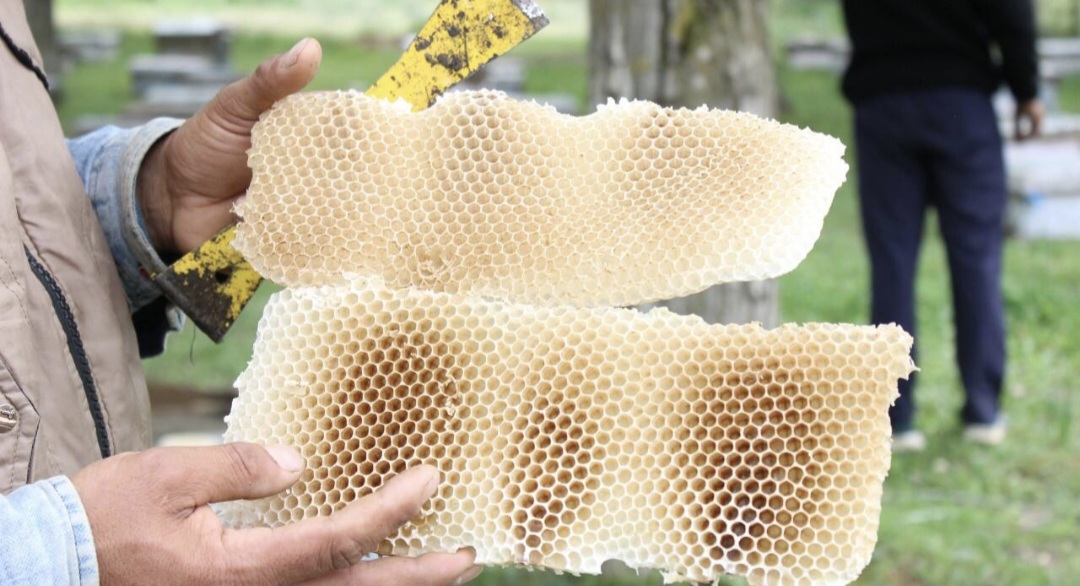As autumn paints the landscape of Kashmir, a cherished ritual unfolds: the harvesting of Maach, the Valley’s sweet elixir. This timeless tradition not only highlights the region’s rich biodiversity but also invites us to reflect on the memories woven into the fabric of our lives.
By Manzoor Akash
As the crisp air of autumn descends upon the picturesque landscape of Kashmir, a cherished ritual unfolds in the Valley: the harvesting of Maach, the sweet elixir of Kashmir’s honey. Locally revered, Maach is not merely a traditional flavor but a name synonymous with the unique cultural significance woven into the fabric of the region. This enduring legacy is a testament to our rich biodiversity and a precious gift bestowed upon us by nature during the enchanting season of Harud. The very act of harvesting Maach serves as a poignant reminder for many to reflect upon their own cherished memories.
Kashmir has long been celebrated as the land of honey (shehad), a fact rooted deeply in its history. Just a few decades ago, it was a rare sight to find a village home without a traditional beehive adorning its exterior. Today, beekeeping (apiculture) has evolved into a thriving industry, presenting exciting opportunities for local youth to embark on profitable ventures using innovative methodologies as apiarists. Yet, despite the modernization of the craft, nothing can truly compete with the timeless allure of the traditional wall-hives that have become emblematic of the region.
Sir Walter Lawrence, in his influential work The Valley of Kashmir, eloquently notes that honey was cultivated in the villages of this region and even served as a form of taxation. Additionally, the illustrious historian Kalhan, in his seminal text Rajatarangini, corroborates that honeybees have existed in Kashmir since ancient times, residing in their natural habitats, and that honey itself was a valuable trade item appreciated for its remarkable medicinal properties.
As autumn blankets the Valley in hues of orange and gold, the remnants of withered flowers beckon people to embark on the time-honored tradition of Maach harvesting. Revered as a natural remedy, Maach is celebrated for its healing properties, serving as a holistic therapy for ailments that afflict both body and spirit. It stands as a testament to the ancient wisdom of the Valley, forming a bridge between the wonders of nature and the human experience.
The Kashmiri variety of honey is regarded as the finest and purest, embodying the essence of a healthy lifestyle. Its thick, golden-hued, sticky consistency, accompanied by an exotic aroma, captivates the senses and delights the palate. This exquisite honey crystallizes slowly, and throughout the ages, it has been esteemed as an Ayurvedic remedy for various ailments, rich in essential vitamins, minerals, and antioxidants critical for the overall development of the human body.
In the Holy Qur’an, Maach is lauded as a supreme source of healing and is enumerated among the foods of Jannah (paradise). The Prophet Muhammad (pbuh) is reported to have said: “By Him in whose hands is my soul; eat honey, for there is no house in which honey is kept, and the angels will not ask for mercy.” Maach has been known to heal wounds, alleviate chronic coughs, bolster immunity, combat depression, and reduce bad cholesterol, among many other benefits. In essence, to consume honey is to invite a thousand remedies into one’s body, while simultaneously banishing a million ailments.
A powerful emblem of Kashmir’s resilience, Maach serves as a poignant reminder of the Valley’s ability to flourish amidst adversity. Much like the honey it produces, the people of Kashmir have learned to extract sweetness from the bitter experiences of life. As we savor the rich, complex flavors of Maach, we must also take a moment to appreciate the beauty of nature and acknowledge the interconnectedness of all living beings on this earth, echoing the words of Sheikh-ul-Alam (RA): “An Poshi Teli, Yeli Wan Poshe.”
I fondly recall how we adhered to the traditional practices of beekeeping, maintaining a Maach Oal (wall-hive) mounted on the wall of our cowshed, adjacent to our home, complete with a wooden box fitted inside. As we prepared to collect honey in mid-autumn, my mother would skillfully produce smoke beneath the hive to gently repel the bees for a brief moment. With her face and hands protected by polythene, she would deftly extract honeycombs, locally known as Maach Kakar, into a woven basket, which would later be crushed and squeezed to yield the liquid gold.
A symbol of wisdom and community, Maach was not only reserved for our winter needs but was also graciously shared with neighbors. I vividly remember the day we had freshly extracted the Maach and invited the Imam of our mosque, whom we affectionately called Gul Saeb, for morning tea. After savoring the Maach paired with Makkai Tchout (maize flour bread), he barely stepped away from us before being ambushed by the honeybees, who were irresistibly drawn to the remnants of honey clinging to his beard.
In the face of modern advancements in honey harvesting, let us not lose sight of our roots and the traditions that have defined our culture. Through our collective efforts, we can safeguard this invaluable cultural legacy for future generations. This humble write-up serves as an endeavor to ensure that the traditional techniques of honey collection remain alive in our memories and practices, passing on the wisdom and richness of our heritage to those who come after us.
The views expressed in this article are solely those of the author and do not necessarily reflect the opinions or views of this Magazine. The author can be reached at [email protected]



Leave a Reply